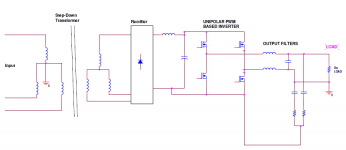Yes, because the transformer isolates the output stage from the mains. You can put that ground anywhere in the output stage. BUT , if you don-t isolate the input from inverter or the driver, you must not ground the input from the inverter or any device connected to the input.
Last edited:
thanqu
hi
thanks for ur reply
i am experimenting now of power level 40kva
regards
naveen
Yes, because the transformer isolates the output stage from the mains. You can put that ground anywhere in the output stage. BUT , if you don-t isolate the input from inverter or the driver, you must not ground the input from the inverter or any device connected to the input.
hi
thanks for ur reply
i am experimenting now of power level 40kva
regards
naveen
Interesting. Somebody who wants to build such a huge device asks such a basic question?
(And with a conventional transformer, instead of SMPS?)
BTW: why is that stage called "unipolar"?
(And with a conventional transformer, instead of SMPS?)
BTW: why is that stage called "unipolar"?
' i have already build class D for BTL upto 70KVAInteresting. Somebody who wants to build such a huge device asks such a basic question?
(And with a conventional transformer, instead of SMPS?)
BTW: why is that stage called "unipolar"?
now my requirement of class D is grounded shaker i thought i can use the same by isolating
since my input is 415V,3Ph (india) i have to step down my voltage for the selection of MOSFETs @ that particular current rating.
UNIPOLAR is a type of PWM technique used for BTL type Class D PAs
Pafi is right, if you work with that voltage and power, you must know that things, otherwise you can take an electrical shock or that thing can explode in your face.. TAKE CARE.
What mosfets are you using for that power ?
What mosfets are you using for that power ?
I use this topology for over 10 years in my D-Amp HVI series. Work well and stable, but you need to use post filter feedback. No need for the 2 cap and resistor that go to V-. Just make sure that you add voltage divider from PSU to front stage to keep each leg of bridge at 1/2 Vcc.
I use this topology for over 10 years in my D-Amp HVI series. Work well and stable, but you need to use post filter feedback. No need for the 2 cap and resistor that go to V-. Just make sure that you add voltage divider from PSU to front stage to keep each leg of bridge at 1/2 Vcc.
THANKS fredos for your suggestion
i appreciate your point of voltage divider technique which is impressive and i will implement it.
I am taking feedback before filter but it is not effective for compensating dead time so i have added cap and resistor to V-. My PWM is uniplor PWM
please suggest for dead time compensation and feddback technique
Pafi is right, if you work with that voltage and power, you must know that things, otherwise you can take an electrical shock or that thing can explode in your face.. TAKE CARE.
What mosfets are you using for that power ?
HI BAGA
I am using 48Amps 500V MOSFETs which are paralleled for required power
- Status
- Not open for further replies.
- Home
- Amplifiers
- Class D
- CLASS D GROUNDED AMPLFIIER
